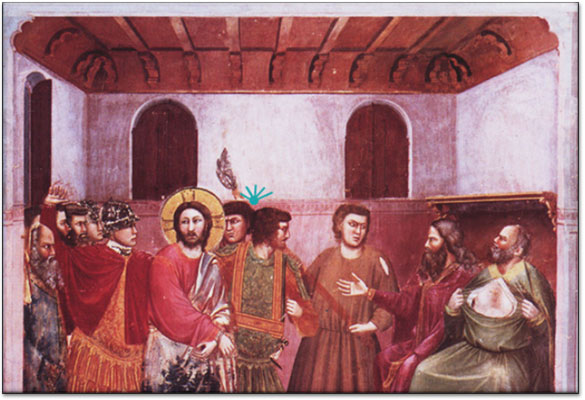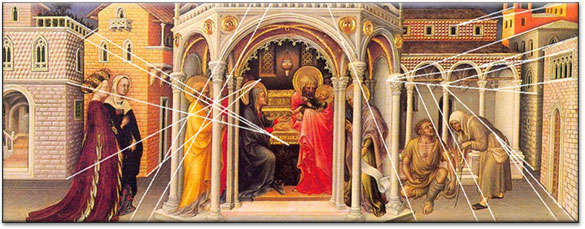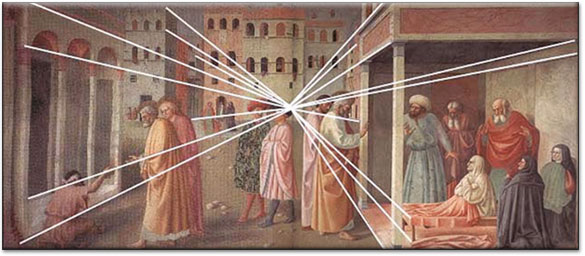The Role of Perspective in Shaping the Renaissance
 |
| Fig. 3. Realigning the rafters to
a single vanishing point at the level of the shelf eliminates the distortion
of the ceiling and the far wall. |
 |
The bowing of the wall is a separate issue that seems to be due to the symmetrically graded shading. The two windows, for example, have symmetrically opposed highlighting that may be accurate if lit by a central window on the near wall, but seems to add to the perceived curvature from the wall shading. Nevertheless, it is odd that the two effects conspire to produce a uniform distortion of the whole wall in the original image (Fig. 2A). Again, the corrected perspective of Fig. 3 minimizes the perceived curvature from the wall shading. Now we tend to reinterpret the shading as an illumination gradient from a restricted light source, and the wall as being flat. In this way, the perspective really seems to be driving the depth interpretation, with the shading gradient having corollary interpretations as a result.
 |
| Fig. 4. ‘The Presentation at
the Temple’ by Gentile di Fabriano (1423). Although the depth
evocation is effective, the projection lines fail to converge to a single
vanishing point in any area of the picture. |
 |
Even a century later than Giotto’s efforts, and a decade or more after Brunelleschi’s reported discovery of perspective, as famous an artist as Gentile di Fabriano shows a complete lack of awareness of the one-point principle. Fig. 4 reproduces Fabriano’s ‘Presentation at the Temple’, painted in 1423 with a composition apparently inspired by Brunelleschi’s depiction of the octagonal Baptistry in Florence. Some of the many perspective lines that should converge to a single central vanishing point are projected with white lines. While the picture is effective at evoking a strong sense of depth, it is patently clear that Fabriano has no concept of how these lines should converge.
 |
| Fig. 5. ‘The Healing of the
Cripple and the Raising of Tabitha’, by Masolino (1425). Note
the accurate central convergence of structures from the front of the
canvas to the far distant background. |
 |
Throughout the 15th century, the new tool of linear perspective was employed by artists with verve to enliven their visual story-telling. One of the first known uses of accurate central convergence was by Masolino in 1425 (Fig. 5), in a picture that tells two separate stories, the healing of the cripple and the raising of Tabitha. Note the full integration of the perspective from the far left to the far right side of the scene, in striking contrast to Fabriano’s attempt. Both interior and exterior lines of the tableaux are integrated into a single vanishing point that is also consistent with the convergence of the streets on both the left and right sides of the background. Moreover, the vanishing point is placed exactly at the eye height of the standing figures (where it must be if the viewer of the scene was standing in the same plaza). This degree of complete integration can only be achieved by an explicit implementation of the concept of a central vanishing point (unless, of course, Masolino used optical projection of the flat scene onto a picture plane, which seems unlikely for a wall fresco such as this work). It seems clear that Masolino had understood, for the first time in history, the power of the central vanishing-point construction in depicting visual space.
The alternative candidate for the first picture with accurate central convergence is the ‘Holy Trinity’, by Masolino’s younger collaborator, Masaccio. Originally dated to 1425, scholars have more recently been moving the estimated execution of this work up to 1426 (Kemp, 1990). Both men traveled together to Rome in 1425 and it seem plausible that they both picked up the zeitgeist of architectural perspective that was developing in Rome at that time. Even if they were painted at the same time, Masolino’s is the more remarkable for the accuracy of its vanishing point and for the integration of foreground and background perspective. The depth in the ‘Holy Trinity’ is relatively shallow, being restricted to the interior of a chapel with an approximately square ground plan (Field, 1997). The only major element receding in depth is the barrel-vaulted ceiling of this chapel. The perspective rendition of this ceiling is a curved version of the tile floors that had been depicted successfully throughout the previous century. Although Masaccio’s solution is perceptually adequate, perspective analysis the recession of its tranversals is flawed. Even the convergence to a central vanishing point is measurably imperfect (Field, Lumadi & Settle, 1989).
